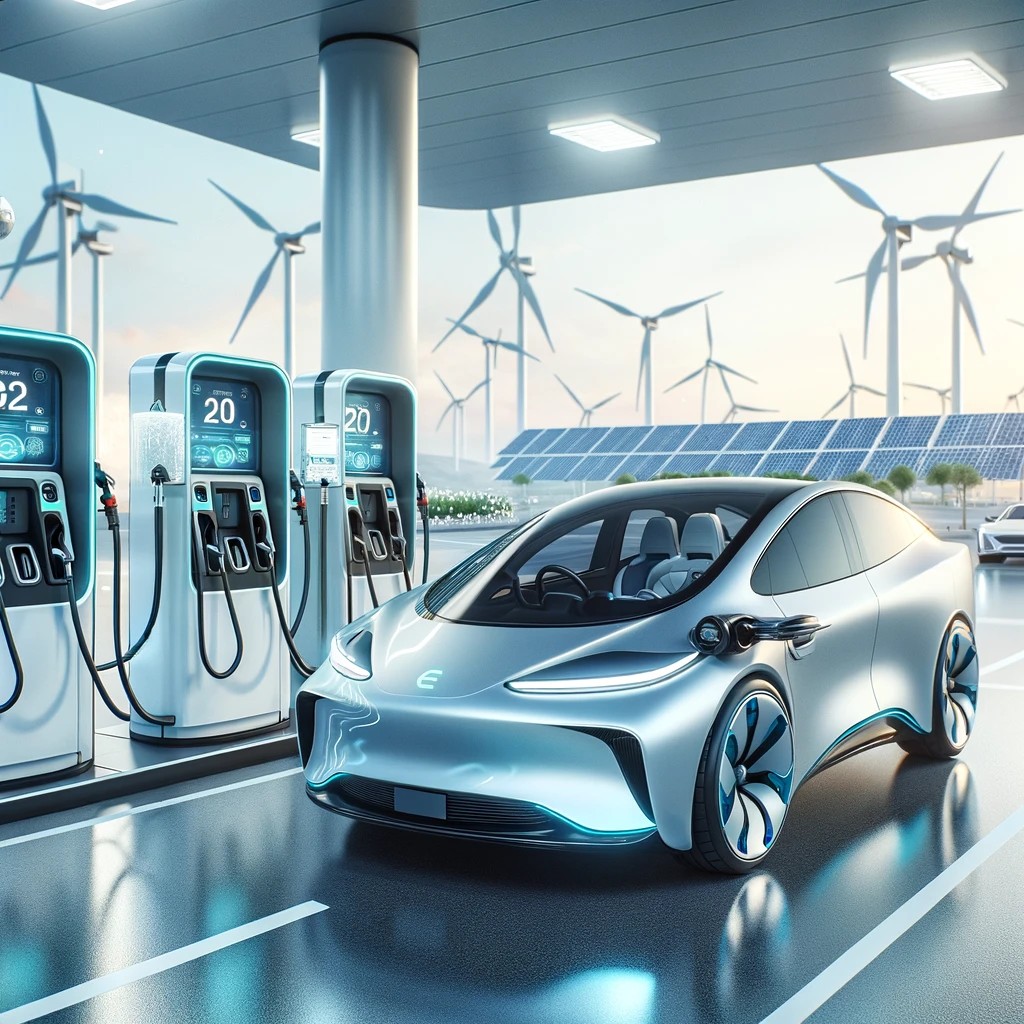Imagine a world where clean, sustainable energy fuels every car on the road—where pollution is reduced, and the future of mobility is powered by hydrogen. This isn’t a distant dream; it’s becoming a reality with the rise of Fuel Cell Electric Vehicles (FCEVs). But for this green revolution to truly take off, one critical component remains: a robust and efficient hydrogen refuelling infrastructure.
Fuel Cell Electric Vehicles (FCEVs) represent a promising leap forward in the pursuit of sustainable transportation. Unlike traditional vehicles that run on gasoline or diesel, FCEVs are powered by hydrogen, emitting only water vapor as a byproduct. This clean technology offers significant environmental benefits, making it a key player in the future of mobility. However, for FCEVs to become mainstream, they need a reliable hydrogen refuelling network to match.
Hydrogen refuelling infrastructure is crucial in ensuring that FCEVs are accessible, reliable, and convenient for everyday use. Without a well-developed network of refuelling stations, the widespread adoption of hydrogen-powered vehicles would face significant hurdles. This article will explore the infrastructural requirements necessary to support FCEVs, from hydrogen production to refuelling stations and storage solutions. It will also look ahead at future developments and innovations in hydrogen refuelling, highlighting the role they will play in accelerating the transition to a cleaner, greener automotive future.
Understanding FCEV Technology
Fuel Cell Electric Vehicles (FCEVs) are powered by hydrogen fuel cells that convert hydrogen gas into electricity to drive the vehicle’s electric motor. At the heart of this technology is the fuel cell, which produces electricity through a chemical reaction between hydrogen and oxygen, emitting only water vapor as a byproduct. This makes FCEVs a truly clean alternative to gasoline-powered vehicles, significantly reducing harmful emissions and helping to combat air pollution.
Hydrogen plays a crucial role in the operation of FCEVs. As a clean energy source, it offers several benefits: it’s abundant, can be produced from a variety of renewable sources, and provides a high energy density, meaning that hydrogen-powered vehicles can achieve long ranges on a single tank. Furthermore, hydrogen can be produced through green methods, such as electrolysis powered by renewable energy, making it an ideal fuel for the future of clean mobility.
When comparing FCEVs to traditional electric vehicles (EVs), the key difference lies in the way they are powered. EVs rely on batteries that are charged by plugging into an electric grid, while FCEVs rely on hydrogen fuel cells for power. Although both are considered clean alternatives to conventional internal combustion engine vehicles, FCEVs offer faster refuelling times (usually under 5 minutes) and longer ranges than many current EVs. However, the widespread adoption of FCEVs hinges on the development of an efficient and accessible hydrogen refuelling infrastructure.
Infrastructural Requirements for Hydrogen Refuellers
Hydrogen Production and Supply
The production of hydrogen is one of the first and most critical steps in creating a viable hydrogen refuelling infrastructure. Hydrogen can be produced through several methods, including electrolysis, where water is split into hydrogen and oxygen using electricity, and steam methane reforming (SMR), which extracts hydrogen from natural gas. Electrolysis is the cleanest option, especially when powered by renewable energy sources like solar and wind, aligning perfectly with the goal of sustainable transportation. SMR, on the other hand, is currently more cost-effective but produces carbon emissions, which are a concern for sustainability.
Once produced, hydrogen needs to be transported to refuelling stations. This presents several logistical challenges, including the need for specialized pipelines or transport via trucks in pressurized tanks. Hydrogen storage and distribution also require careful planning to ensure that enough fuel is available at stations to meet demand, which can vary by location and time of day. The supply chain must be carefully managed to prevent shortages and ensure efficiency.
Refuelling Stations
Hydrogen refuelling stations are the backbone of the hydrogen infrastructure. These stations are equipped with several key components, such as compressors to increase the pressure of hydrogen for storage and dispensing, storage tanks to hold large quantities of hydrogen, and dispensers to deliver hydrogen to vehicles. Ensuring compatibility between refuelling stations and FCEVs is crucial, which includes maintaining the correct pressure levels (typically 700 bar for passenger vehicles) and using nozzles that fit FCEV refuelling ports.
Safety is another top priority, as hydrogen is highly flammable. Refuelling stations must comply with stringent safety standards and regulations to prevent accidents. These regulations govern everything from the design of the station to the training of personnel, ensuring that both consumers and workers are safe during the refuelling process.
Storage and Distribution Networks
Hydrogen storage plays a significant role in ensuring that hydrogen refuelling stations have enough supply to meet demand. The infrastructure must be capable of storing large volumes of hydrogen in safe, efficient ways. Storage systems vary, with options including underground storage or high-pressure tanks. The distribution of hydrogen must also be carefully managed through pipelines or hydrogen transport vehicles to ensure a consistent and reliable supply chain.
Energy Grid Integration
Integrating hydrogen production into the existing energy grid is another challenge. Ideally, hydrogen production will be powered by renewable energy sources such as wind or solar power. However, the intermittent nature of these sources can make it difficult to produce hydrogen on demand. Solutions, such as energy storage systems or flexible electrolysis plants that can respond to fluctuations in renewable energy generation, will be key to ensuring a reliable and sustainable supply of hydrogen for refuelling stations.
Challenges in Building Hydrogen Refuelling Infrastructure
Building a comprehensive hydrogen refuelling infrastructure faces several challenges, starting with high initial capital costs. Establishing hydrogen production facilities, storage, and refuelling stations requires substantial investment, which may deter some stakeholders from entering the market. Additionally, the geographic distribution of hydrogen stations presents a challenge, particularly in rural areas where demand may be lower. Concentrating infrastructure in urban centers may lead to inequities in access.
Regulatory and safety concerns also pose obstacles, with varying standards across regions and the need to harmonize regulations internationally. Public perception is another challenge; many consumers are still unfamiliar with hydrogen as a fuel source and may be hesitant to adopt FCEVs. Overcoming these adoption hurdles will require significant public education and awareness campaigns.
Finally, the technical challenges of refuelling speed and station reliability need to be addressed. While FCEVs offer quick refuelling times compared to EVs, ensuring that stations operate smoothly under high demand and providing consistently high-quality hydrogen will be key to maintaining customer confidence.
Future Developments and Innovations
The future of hydrogen refuelling infrastructure is full of promise, thanks to ongoing technological advancements in hydrogen production. As green hydrogen technologies continue to improve, the scalability of electrolysis will make it more feasible to produce large quantities of clean hydrogen. Innovations in hydrogen production, such as solid oxide electrolysis or photoelectrochemical cells, may further reduce costs and increase efficiency.
The development of next-generation refuelling stations is also on the horizon. Faster refuelling technologies are being explored to minimize wait times for FCEV drivers, and smart refuelling stations could integrate digital technologies for better management and user experience. These stations may incorporate predictive maintenance systems to ensure reliability and prevent downtime.
Global efforts to expand hydrogen networks are underway, with governments and private sectors investing in the infrastructure necessary to support widespread adoption. Countries like Japan, Germany, and the United States are leading the way in building hydrogen networks, while innovative collaborative efforts between automakers, energy companies, and governments are accelerating the development of hydrogen solutions.
Case Studies and Real-World Examples
Regions like California, Europe, and Japan have already made significant strides in establishing hydrogen refuelling infrastructure. In California, the state’s Hydrogen Highway initiative has led to a growing network of refuelling stations, facilitating the adoption of FCEVs. Similarly, Japan’s government-backed push for hydrogen has resulted in an extensive network of hydrogen stations across the country. These efforts provide valuable insights into the challenges and successes of scaling hydrogen infrastructure.
Conclusion
In conclusion, the adoption of FCEVs is heavily reliant on the development of a comprehensive hydrogen refuelling infrastructure. Key elements such as hydrogen production, refuelling stations, storage, and distribution must work in tandem to support this emerging technology. The future of hydrogen refuelling is bright, driven by technological innovations and collaborations between governments, businesses, and research institutions. As these efforts progress, hydrogen refuelling infrastructure will become more widespread, helping to accelerate the transition to a cleaner, greener future.
Frequently Asked Questions (FAQs)
1. What are Fuel Cell Electric Vehicles (FCEVs)?
Fuel Cell Electric Vehicles (FCEVs) are vehicles that use hydrogen fuel cells to generate electricity, which powers the vehicle’s motor. The key advantage of FCEVs is that they produce zero emissions, emitting only water vapor as a byproduct.
2. How do hydrogen fuel cells work in FCEVs?
Hydrogen fuel cells work by combining hydrogen with oxygen from the air in a chemical reaction that generates electricity. This electricity powers the electric motor of the vehicle. The only byproduct of this process is water vapor, making FCEVs a clean alternative to gasoline-powered vehicles.
3. What are the key components of a hydrogen refuelling station?
A hydrogen refuelling station typically includes compressors to pressurize the hydrogen, storage tanks to hold large quantities of hydrogen, and dispensers to deliver the fuel into vehicles. Stations must meet strict safety standards to ensure the safe handling of hydrogen.
4. How is hydrogen produced for use in refuelling stations?
Hydrogen can be produced through various methods, including electrolysis (splitting water into hydrogen and oxygen using electricity) and steam methane reforming (SMR), which extracts hydrogen from natural gas. Electrolysis is the cleanest method when powered by renewable energy sources like wind or solar.
5. What are the challenges in building hydrogen refuelling infrastructure?
Challenges include high capital costs, geographical distribution (ensuring stations are accessible in both urban and rural areas), regulatory hurdles, safety concerns, and technical challenges such as ensuring fast and reliable refuelling speeds. Public perception of hydrogen as a fuel source can also hinder adoption.
6. How long does it take to refuel an FCEV?
Hydrogen refuelling typically takes about 3 to 5 minutes, which is much quicker compared to charging a battery electric vehicle (EV), making FCEVs more convenient for long-distance travel.
7. Are there any safety concerns with hydrogen refuelling stations?
Yes, hydrogen is highly flammable, so hydrogen refuelling stations must adhere to strict safety standards. These stations are equipped with advanced safety measures, such as automatic shut-off systems, fire suppression systems, and regular maintenance checks to minimize risks.
8. How will the integration of renewable energy impact hydrogen refuelling infrastructure?
Integrating renewable energy sources like wind and solar into hydrogen production is essential for creating green hydrogen. This integration ensures that hydrogen production is sustainable, but it also presents challenges related to energy storage and balancing supply and demand due to the intermittent nature of renewable sources.
9. What is the role of governments in expanding hydrogen infrastructure?
Governments play a key role in funding and incentivizing the development of hydrogen infrastructure. Many countries have implemented policies and provided subsidies to support hydrogen fuel production, refuelling stations, and the development of fuel cell technology.
10. How does the future of hydrogen refuelling infrastructure look?
The future of hydrogen refuelling infrastructure is promising, with advancements in hydrogen production technology, faster refuelling methods, and expanding networks. Governments, automakers, and energy companies are collaborating to develop the infrastructure needed for widespread adoption of FCEVs, and we can expect to see significant growth in hydrogen stations worldwide over the coming years.

